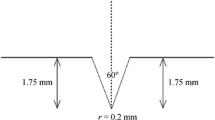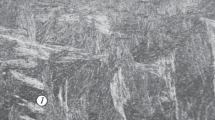Abstract
The effects of precycling and surface removal on the fatigue life and fatigue limit of a Ti-6A1-4V alloy were investigated. It was shown that both the fatigue life and fatigue limit were strongly dependent on the severity of precycling. The fatigue limit lost its significance if the alloy was subjected to a precycling treatment with a high stress amplitude. Cycling with stress amplitude below the fatigue limit after precycling showed a dependence of the logarithmic number of cycles to failure on the fraction of prefatigue damage. The interdependence of fatigue life and fatigue limit to precycling history was attributed to microcrack formation, principally restricted to a surface layer of less than 100 µm. Depending on the severity of precycling and on the magnitude of the applied cyclic stress, the fatigue damage could be either partially or totally eliminated by surface removal. The α/β interphase region of the surface layer appeared to offer preferred sites for dislocation pile-ups and crack initiation.
Similar content being viewed by others
References
H. Shen, S.E. Podlaseck, and I. R. Kramer:Trans. TMS-AIME, 1965, vol. 233, p. 1933.
H. Shen and I. R. Kramer:Trans. International Vacuum Soc, 1967, p. 263.
I. R. Kramer:Proc. Air Force Conf. on Fatigue and Fracture, AFCDL-TR-O-144, December 1969, p. 271.
I.R. Kramer:Metall. Trans., 1974, vol. 5, p. 1735.
B. I. Verkin and N. M. Grinberg:Mat. Sci. and Eng., 1979, vol. 41, p. 149.
C.H. Wells and C.P. Sullivan:Trans. ASM, 1964, vol. 57, p. 541.
D. K. Benson, I. C. Grosskreutz, and G.G. Shaw:Metall. Trans., 1972, vol. 3, p. 1239.
R. N. Pangborn, S. Weissmann, and I. R. Kramer:Metall. Trans. A, 1981, vol. 12A, p. 109.
S. Weissmann and D. L. Evans:Acta Cryst., 1954, vol. 7, p. 733. 10. S. Weissmann: J. Appl. Phys., 1956, vol. 27, p. 389.
S. Weissmann:Trans. ASM, 1960, vol. 52, p. 599.
R. Yazici, W. Mayo, T. Takemoto, and S. Weissmann:J. Appl. Cryst., 1983, vol. 16, in press.
J. Ruppen, P. Bhowal, D. Eylon, and A.J. McEvily:Fatigue Mechanisms, Jeffrey T. Fong, ed., ASTM STP 675, Philadelphia, PA, 1979, p. 47.
R. K. Steele and A.J. McEvily:Engineering Fracture Mechanics, 1976, vol. 8, p. 31.
D.F. Neal and P.A. Blenkinsop:Acta Met., 1976, vol. 24, p. 59.
D. Eylon and J.A. Hall:Metall. Trans. A, 1977, vol. 8A, p. 981.
R. Chait and T. S. DeSisto:Metall. Trans. A, 1977, vol. 8A, p. 1017.
Author information
Authors and Affiliations
Rights and permissions
About this article
Cite this article
Takemoto, T., Jing, K.L., Tsakalakos, T. et al. The importance of surface layer on fatigue behavior of a Ti- 6AI- 4V alloy. Metall Trans A 14, 127–132 (1983). https://doi.org/10.1007/BF02643745
Received:
Issue Date:
DOI: https://doi.org/10.1007/BF02643745




